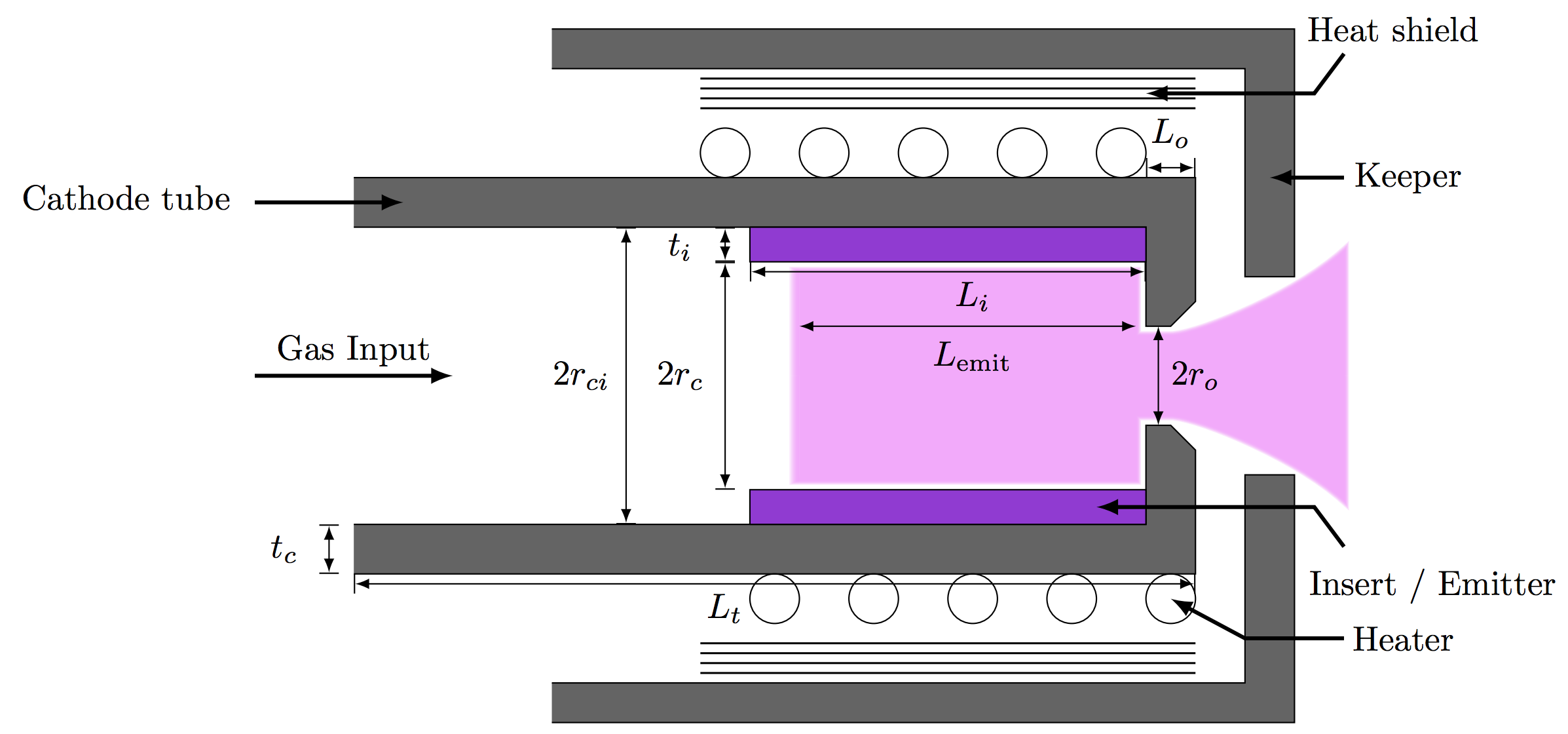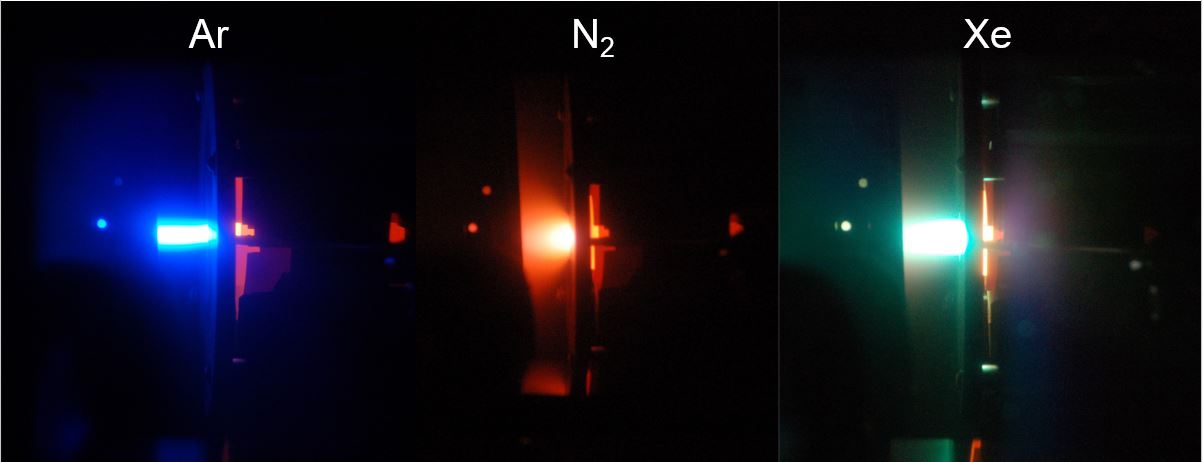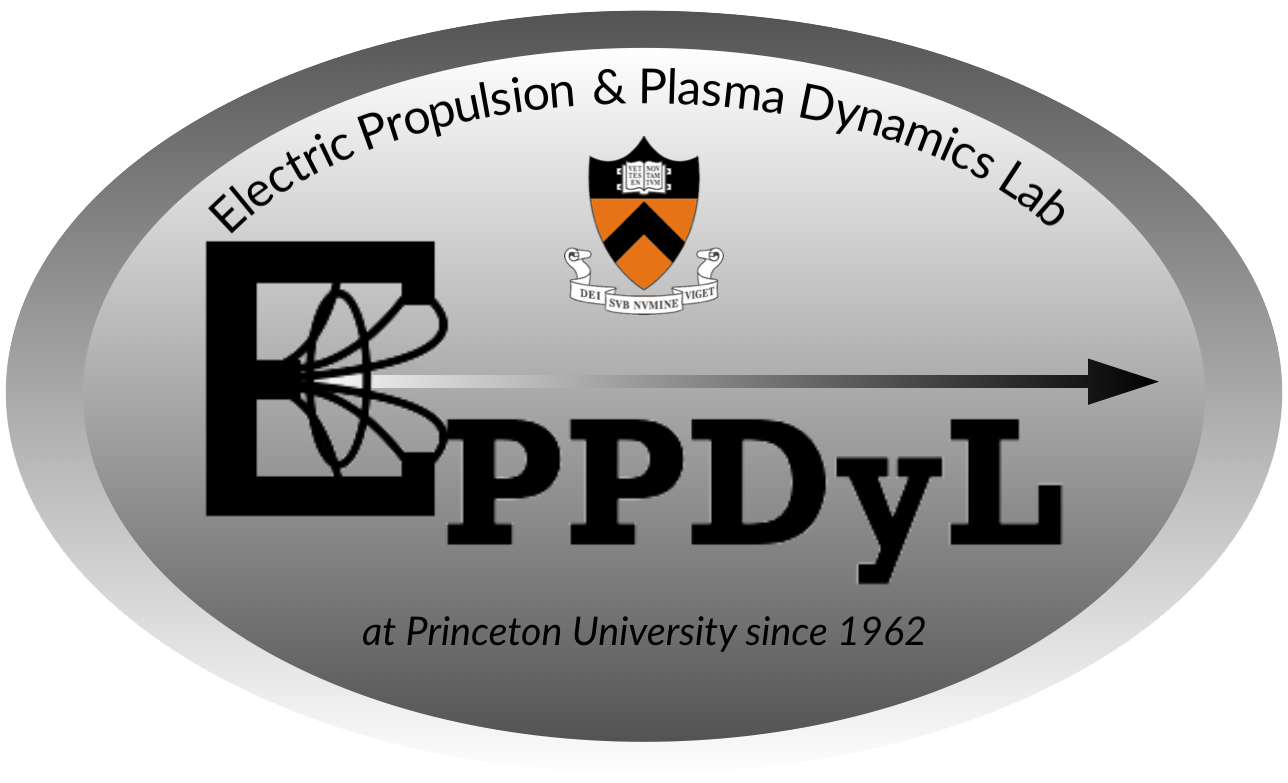High-Current Hollow Cathode Development
Research supported by:
Air Force Office of Scientific Research, and
the Princeton Plasma Physics Laboratory's Program in Plasma Science and Technology
What are orificed hollow cathodes?
Hollow cathodes are a critical component of most in-space electric propulsion devices. Hollow cathodes act as both neutralizers and plasma sources for Hall and ion thrusters and affect the operational lifetime, maximum discharge power, and performance of these thrusters.
Hollow cathodes typically employ a conductive tube with a low work function insert. Due to its low work function, the insert thermionically emits electrons at relatively low operating temperatures (1000-1700\(^\circ\)C) and at high current densities (up to 20 A/cm2), while maintaining a long operational lifetime. A neutral gas (e.g., xenon) is fed into the upstream end of the cathode cavity; emitted electrons ionize the gas as it travels downstream. This ionization creates a dense plasma in the insert region which prevents space-charge-limited emission and allows the emitter surface to operate at high current densities. A schematic drawing of a typical hollow cathode is shown below.

Orificed hollow cathodes are used instead of solid filament cathodes or single-channel cathodes due to their ability to supply high electron current densities at relatively low voltages and temperatures, requiring less power as well as providing much longer operational lifetimes. Orificed hollow cathodes operate at higher pressure as compared to single-channel hollow cathodes for the same mass flow rate, which suppresses the sheath voltage and prevents space-charge limitation.
Motivation
Hollow cathodes are one of the last remaining life-limiting components of modern Hall and ion thrusters. As flight missions become more demanding (e.g., 100-200 kW thrusters) and larger power sources become available, hollow cathodes are quickly being pushed to their limits. Future hollow cathodes will need to be able to handle much higher discharge currents (up to 600-700 A), and recently proposed missions require lifetimes to be about twice that of the longest life tests to date.
A strategy for accomplishing these goals involves creating and testing new hollow cathode concepts that lower the peak current density while maintaining the same discharge current. The peak current density limits the operational life of the cathode, as it is directly related to the maximum evaporation rate of the emitter. Lowering the peak current density while maintaining the same discharge current increases the operational lifetime, for given operating conditions. One of the concepts conceived at EPPDyL to achieve this is the RF-Controlled Hollow Cathode (RF-CHC).
Current Work
Recent work focuses on a theroretical understanding of the mechanisms driving the plasma attachment length. We have presented a review of existing theoretical models at the 53rd AIAA Joint Propulsion Conference in 2017. A fundamental understanding of the scaling of the plasma attachment length and other performance parameters is necessary in order to design new cathodes without the use of experimental data. Novel concepts such as the RF-controlled Hollow Cathode also rely on the understanding of this behavior in order to demonstrate improvements in performance.
We have developed multiple scaling laws for fundamental plasma quantities (electron temperature, attachment length, total pressure) based on an empirical analysis of the total pressure inside cathodes on and a new 0-D model. The empirical analysis and theoretical model were presented at the 2018 and 2019 AIAA Propulsion and Energy Forums. Scaling laws were presented for the attachment length and electron temperature in the 2019 International Electric Propulsion Conference.
In order to facilitate repeatable experiments with large hollow cathodes, we have designed a high-power graphite heater that allows reliable ignition, and is capable of providing one order of magnitude more power than existing designs. The heater is shown in Figure 2 below. With this prototype heater, we have been able to operate our large hollow cathode using multiple propellants over a large range of discharge currents, up to 400 A, as shown in Figure 3.


Past work: RF-Controlled Hollow Cathode (RF-CHC)
This concept couples RF or microwave power to a large-diameter hollow cathode in attempt to control the axial plasma density profile. The RF-CHC concept was first presented at the 48th AIAA Joint Propulsion Conference in 2012, and numerical modeling of the concept was presented at the 49th AIAA Joint Propulsion Conference in July of 2013. We presented our initial experimental findings of the RF-CHC at the 33rd International Electric Propulsion Conference in October 2013.
Publications
- Scaling Laws in Orificed Thermionic Hollow Cathodes (2020)
- The influence of ambipolar diffusion on the attachment length and electron temperature in orificed hollow cathodes (2019)
- A 0-D model for orificed hollow cathodes with application to the scaling of total pressure (2019)
- Design and Implementation of an Actuated Probe Suite for an Orificed Hollow Cathode (2018)
- An empirical scaling relationship for the total pressure in hollow cathodes (2018)
- Multi-kilowatt-class heaters for large hollow cathodes (2018)
- A Critical Review of Orificed Hollow Cathode Modeling: 0-D Models (2017)
- The RF-Controlled Cathode: Modeling and Large-Diameter Cathode Experimental Results (2016)
- Multiple-Kilowatt-Class Graphite Heater for Large Hollow Cathode Ignition (2015)
- Experimental Investigation of a Large Diameter Cathode (2014)
- Modeling and Development of the RF-Controlled Hollow Cathode Concept (2013)
- Resonant Mode Transition in the RF-Controlled Hollow Cathode (2013)
- Exploration of RF-Controlled High Current Density Hollow Cathode Concepts (2012)
Contact
Currently at Princeton:Former students:- Pierre-Yves Taunay
- Matt Plasek
- Sebastian Rojas Mata
- Nicholas Luzzaraga
